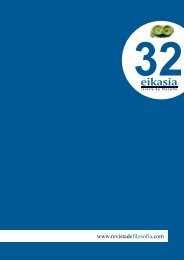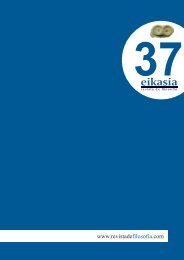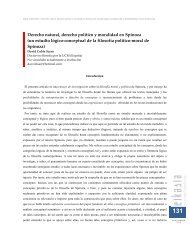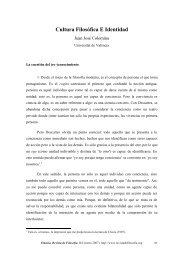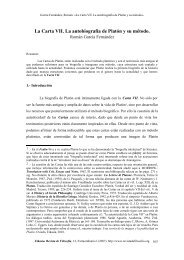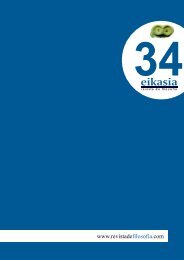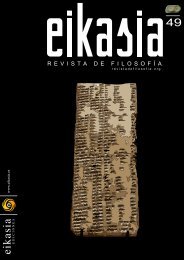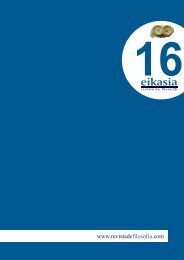Descargar número completo (4,15 MB) - Eikasia
Descargar número completo (4,15 MB) - Eikasia
Descargar número completo (4,15 MB) - Eikasia
You also want an ePaper? Increase the reach of your titles
YUMPU automatically turns print PDFs into web optimized ePapers that Google loves.
Una interpretación no-regularista de la causalidad humeana | Sílvio Mota Pinto<br />
But if Hume’s theory is true, then anyone who agrees that there is in fact a constant conjunction<br />
between phenomena (C) and (E) will come to believe Hume’s theory. That theory says that when we have<br />
found a constant conjunction between two sorts of phenomena (C) and (E), we will inevitably believe that<br />
phenomena of the (C) sort are the causes of phenomena of the (E) sort. (Stroud 1977, p. 92).<br />
Hume begins his discussion of causality by distinguishing causality from what I called ‘mere<br />
coincidence’. Two events can be related by contiguity and temporal priority without being thought of as<br />
causally connected. But when we have observed a number of events of the same kinds and found them to<br />
be constantly conjoined, he says we will come to believe that they are related causally. The repeated<br />
observation of similar phenomena precludes our thinking of them as occurring together merely<br />
coincidentally. (Stroud 1977, p. 93).<br />
Ahora bien, lo que me parece inadecuada en este contexto es la interpretación regularista de la causalidad<br />
humeana. Me explico. La última cita del Tratado sugiere que, aunque la aplicación no reflexiva del concepto de<br />
causalidad 24 nos lleva a inferir juicios causales muchas veces equivocados, habría un mecanismo reflexivo más<br />
sensible al error por medio del cual ponemos a prueba los resultados obtenidos por el hábito causal. Este<br />
mecanismo perteneciente al entendimiento o a la razón está constituido de las 8 reglas mencionadas arriba: en<br />
particular de las 4 últimas, ya que las 4 primeras constituyen el hábito causal humeano. Esto es lo que nos dice en el<br />
siguiente pasaje:<br />
According to my system, all reasonings are nothing but the effects of custom; and custom has no<br />
influence, but by enlivening the imagination, and giving us a strong conception of any object. It may,<br />
therefore, be concluded, that our judgment and imagination can never be contrary, and that custom cannot<br />
operate on the latter faculty after such a manner, as to render it opposite to the former. This difficulty we<br />
can remove after no other manner, than by supposing the influence of general rules. We shall afterwards<br />
take notice of some general rules [the 8 rules mentioned above], by which we ought to regulate our<br />
judgment concerning causes and effects; and these rules are form’d on the nature of our understanding, and<br />
on our experience of its operations in the judgments we form concerning objects. By them we learn to<br />
distinguish the accidental circumstances from the efficacious causes; and when we find that an effect can<br />
be produc’d without the concurrence of any particular circumstance, we conclude that that circumstance<br />
makes not part of the efficacious cause, however frequently conjoin’d with it. But as this frequent<br />
conjunction necessarily makes it have some effect on the imagination, in spite of the opposite conclusion<br />
from general rules, the opposition of these two principles produces a contrariety in our thoughts, and<br />
causes us to ascribe the one inference to our judgment, and the other to our imagination. The general rule is<br />
attributed to our judgment; as being more extensive and constant. The exception to the imagination; as<br />
being more capricious and uncertain. 25 (Hume 1888, libro I, parte III, sección XIII)<br />
162<br />
La propuesta humeana es entonces que el concepto <strong>completo</strong> de causalidad se constituye de una parte no<br />
reflexiva debida a los sentidos, la memoria y la imaginación, que incluiría las impresiones asociadas a la secuencia<br />
de pares de sucesos naturales observados más las 4 primeras reglas (contigüidad entre C y E, secuencia temporal,<br />
conjunción constante, generalización de la conjunción constante), y de una parte reflexiva debida al entendimiento,<br />
la cual incluiría las 4 últimas reglas mencionadas. De acuerdo con lo que afirma nuestro autor en la cita, es<br />
justamente esta parte reflexiva la que nos permite corregir nuestros juicios causales irreflexivos y, a la larga,<br />
MARZO<br />
2012<br />
24 En la cual intervienen, como ya lo sabemos, los sentidos, la memoria y la imaginación.<br />
25 El énfasis es mío.



